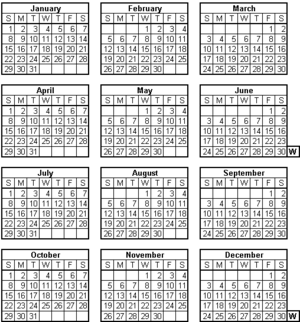World calendar facts for kids
The World Calendar is a special way to organize the year, similar to the Gregorian calendar we use today. A woman named Elisabeth Achelis from Brooklyn, New York, created this idea in 1930. She wanted to make a calendar that was more regular and easier to use.
How the World Calendar Works
The World Calendar has 12 months, just like our current calendar. It's a 'perennial' calendar, which means it stays the same every year. You wouldn't need a new calendar each year!
It divides the year into four equal parts, called 'quarters.' Each of these quarters starts on a Sunday and finishes on a Saturday. Every quarter has exactly 91 days, which is 13 weeks or 3 months.
The months within each quarter have a set number of days:
- The first month has 31 days.
- The second month has 30 days.
- The third month has 30 days.
To make sure the calendar always starts on the same day, the World Calendar adds two special days. These days are not part of any week:
- Worldsday: This day comes after December 30th. It's like an extra day at the very end of the year.
- Leapyear Day: This day is added after June 30th, but only in a leap year.
Why Some People Don't Like It
The main reason some people don't support the World Calendar is because of religious reasons. Many religions have a special day each week for worship.
- Jews worship on Saturday. This is based on their holy book, the Hebrew Bible.
- Christians worship on Sunday. They believe this is the day Jesus was resurrected.
- Muslims worship on Friday. They believe Adam was created on this day.
With the World Calendar, these special worship days would sometimes shift. For example, if Worldsday or Leapyear Day happened, the next week's days would be pushed forward. This would mean that a Saturday, Sunday, or Friday might not always be the same day of the week each year. Because of this, the United Nations did not approve the calendar.
Related Pages
See also
 In Spanish: Calendario Mundial para niños
In Spanish: Calendario Mundial para niños


